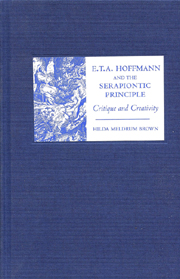Book contents
- Frontmatter
- Contents
- List of Illustrations
- Preface
- Acknowledgments
- List of Abbreviations
- Introduction: Approaches to the Serapiontic Principle
- Part 1
- Part 2
- 7 Frame Narrative and the Serapiontic Principle
- 8 From Visual to Verbal: Three Serapiontic Tales
- 9 The “Nachtseite der Natur” and the Serapiontic Principle
- 10 The Märchen and the Serapiontic Principle
- 11 The Serapiontic Principle: The Wider Critique
- Conclusion
- Select Bibliography
- Index
9 - The “Nachtseite der Natur” and the Serapiontic Principle
from Part 2
Published online by Cambridge University Press: 05 February 2013
- Frontmatter
- Contents
- List of Illustrations
- Preface
- Acknowledgments
- List of Abbreviations
- Introduction: Approaches to the Serapiontic Principle
- Part 1
- Part 2
- 7 Frame Narrative and the Serapiontic Principle
- 8 From Visual to Verbal: Three Serapiontic Tales
- 9 The “Nachtseite der Natur” and the Serapiontic Principle
- 10 The Märchen and the Serapiontic Principle
- 11 The Serapiontic Principle: The Wider Critique
- Conclusion
- Select Bibliography
- Index
Summary
Introduction
As we have already noted, topical issues such as magnetism and somnambulism play an important part in Hoffmann's thinking, and link up with the fundamental mind-body question that was being formulated at the time in terms of the relationship between “Geist” and “Natur.” Hoffmann had followed debates about these topics in contemporary thinking at a theoretical level, in the writings of Schelling and Schubert, and at a more practical, psychological level in the influential treatises of Reil and Pinel. His close personal acquaintance with the influential medical director of the Bamberg hospital, Adalbert Friedrich Marcus, suggests that he had plenty of direct access to authoritative sources of information, and enough certainly to have formed his own opinions.
After the carefully planned first volume of the Serapionsbrüder tales, themes relating to the Occult occur more and more frequently: the third “Abschnitt” for example, contains two such tales (Die Automate and the untitled Eine Spukgeschichte) as well as an introduction to this entire section in which there is lengthy discussion about the Occult among the members of the Bund; this is then followed by two anecdotes by Theodor that are presented as illustrations. Hoffmann clearly intends — in his typically undogmatic way — to provide his readers with an introduction to these topics as preparation for the subsequent tales in the collection that will draw on these areas to which Schubert had given the useful portmanteau term “Die Nachtseite der Natur.”
- Type
- Chapter
- Information
- E. T. A. Hoffmann and the Serapiontic PrincipleCritique and Creativity, pp. 157 - 168Publisher: Boydell & BrewerPrint publication year: 2006



